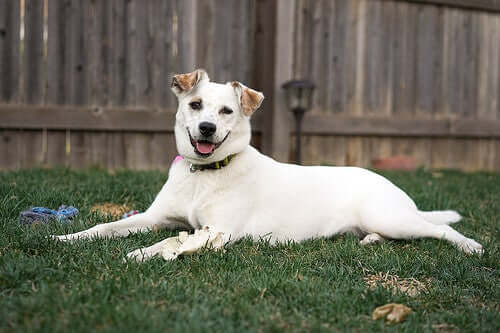Acne in Pets


Written and verified by the lawyer Francisco María García
Acne in pets happens when hair follicles on the skin get infected. It doesn’t have major medical consequences, but it does need to be taken care of.
This skin rash in pets occurs during puberty, between the ages of three and twelve months. It’s very rare to see cases in adult animals.
Where does acne appear on pets?
The most common places it will appear are the head, limbs and back; also on the snout and genitals. This skin infection is more common in short-haired dogs, as the follicles become clogged with the skin’s own sebum. Cats can also get it.

Acne will look the same on your pet as it does on a person. It looks like a lump and abscess on the skin that is red and filled with pus. These are commonly known as pimples. In some cases, the pimple is internal; therefore, it will only look like a lump.
Many times these lumps go unnoticed, so you need to examine your dog thoroughly when bathing it. Also while you are stroking or combing your pet you will see the bumps.
In animals, acne can cause itching or discomfort, which makes dogs scratch regularly. Most of the time this leads to further infection in the area. For these reasons, it’s important to keep the affected area clean.
How to treat your pet’s acne
Acne evolves and improves once your pet reaches adulthood. When your pet is about 12 months old, it starts to disappear or become invisible.
However, if acne persists, you can improve the appearance of your pet by following certain measures. Similarly, you can treat the discomfort caused by the lumps.
- First of all, you need to keep your dog clean. Using specialized animal shampoo reduces the presence of oil or sebum on the skin, which causes pores to clog.
It’s even more important to keep them clean if they already have pimples. On days when you don’t bathe your pet, you can clean the affected area with a little hydrogen peroxide and cotton.
- Don’t use products that aren’t recommended for animals, mainly because it could further irritate the affected area or create allergies.
- Products developed to treat acne in people can dry animals’ skin.
- Avoid squeezing or popping the lump as this can cause further infection and even form abscesses. Once the pimple matures, it will explode on its own and disappear.
- It’s important to see a specialist. An evaluation can rule out some hormonal disorder as a product of acne in pets, especially if it’s a dog or adult animal.
- It’s only when acne is chronic that antibiotics or anti-inflammatory drugs are recommended. You must always administer any medication under the supervision of a specialist.
Homemade acne treatments for pets
Although it’s recommended to visit a specialist for any illness or condition, other options can be used. Some topical treatments improve acne in animals, although, before this, it’s important to clean the affected area.

- For example, calendula is a plant known for its anti-inflammatory and antiseptic effects. Dilute five drops of calendula in 3fl oz of water before applying it to the affected area. You can’t apply the plant directly to acne, as it can worsen the condition.
- Another recommended treatment is aloe vera, which can be used as a gel or cream. Try to use the most natural gels or creams as commercial ones contain perfume or dye.
- Aloe vera is an astringent plant that quickly reduces acne.
- Green tea leaves also have healing properties for pimples and blackheads.
- You can apply water or tea bags directly to the affected area and it will serve as an anti-inflammatory.
This text is provided for informational purposes only and does not replace consultation with a professional. If in doubt, consult your specialist.